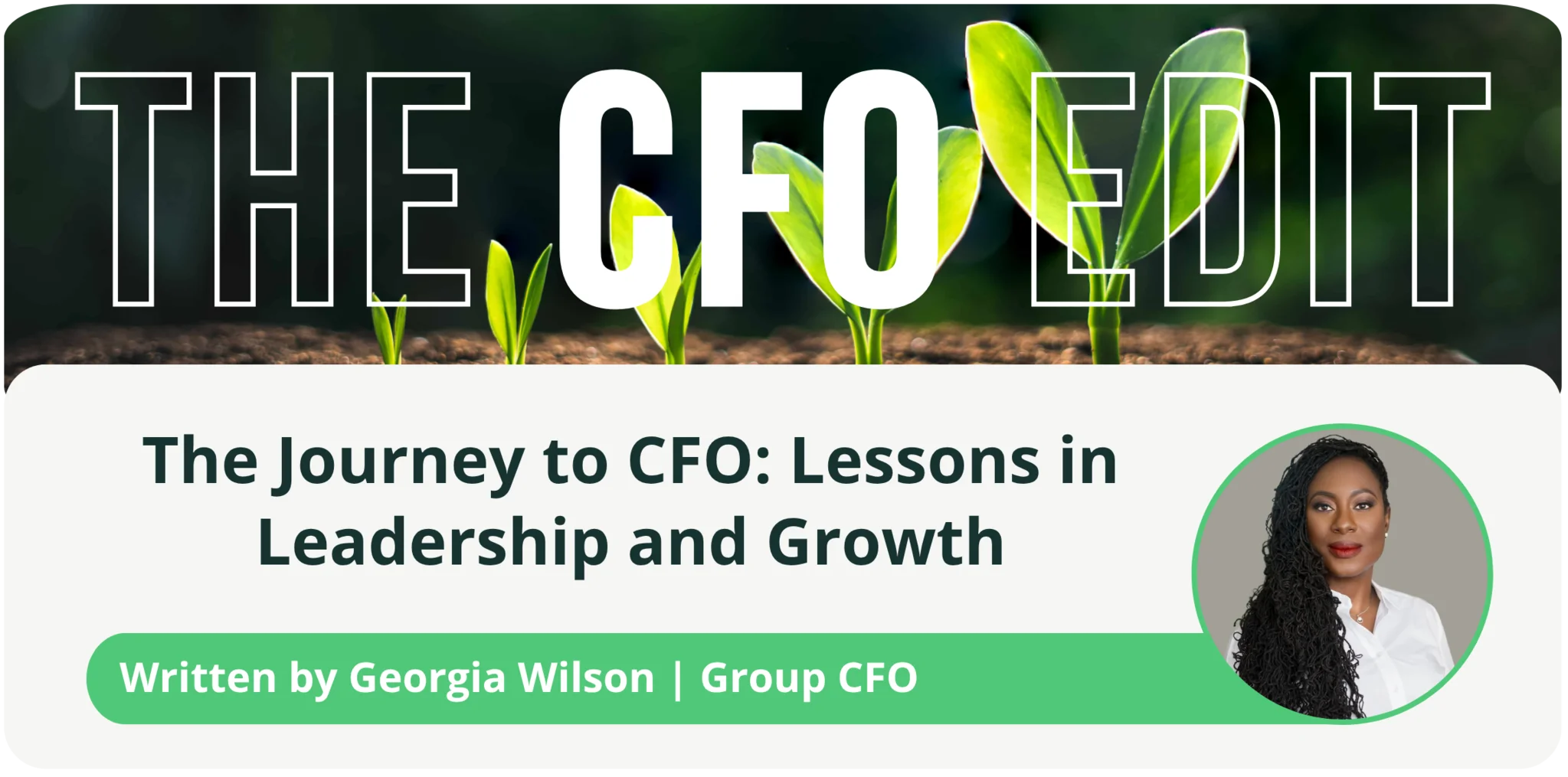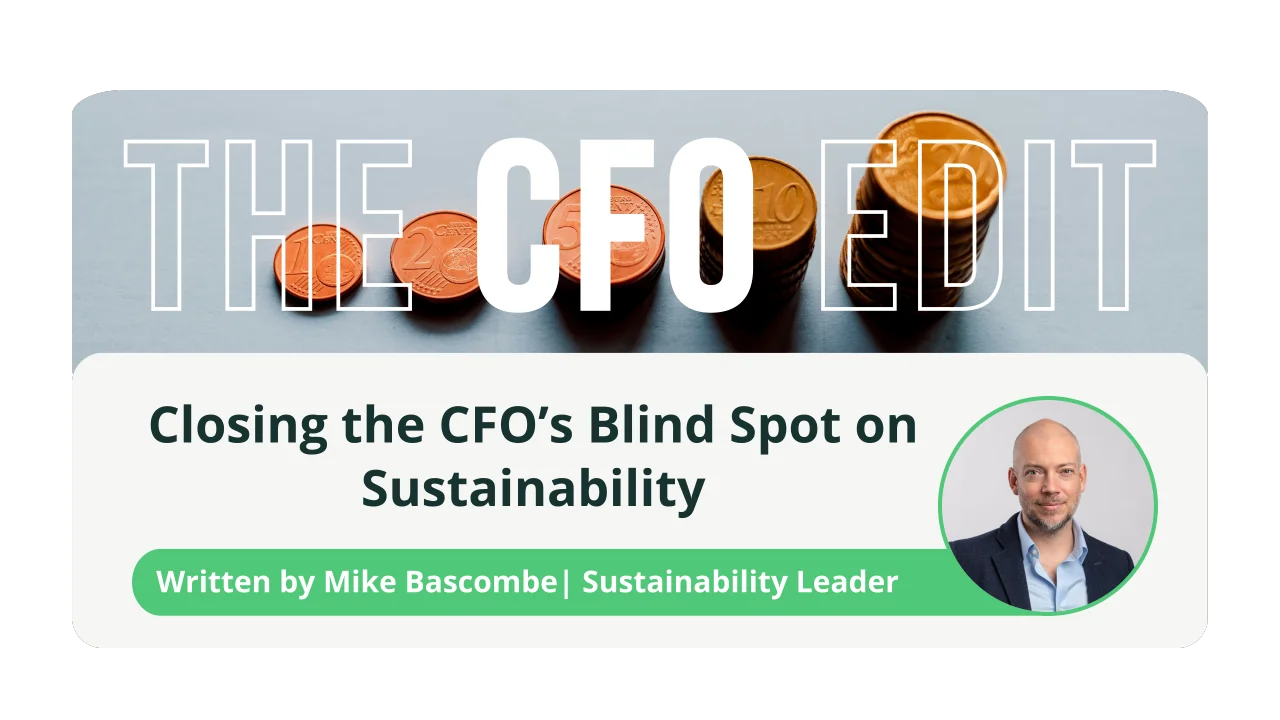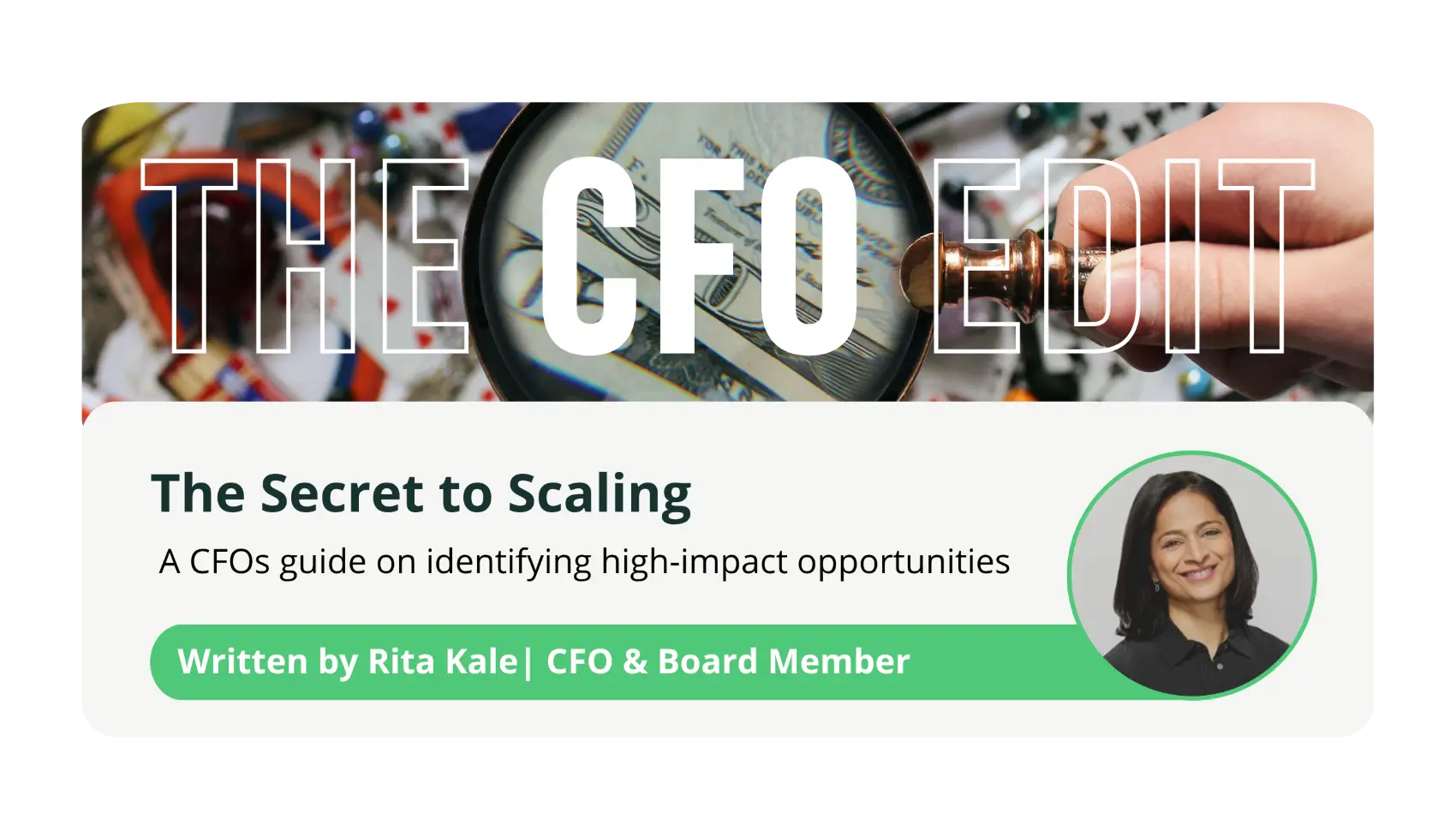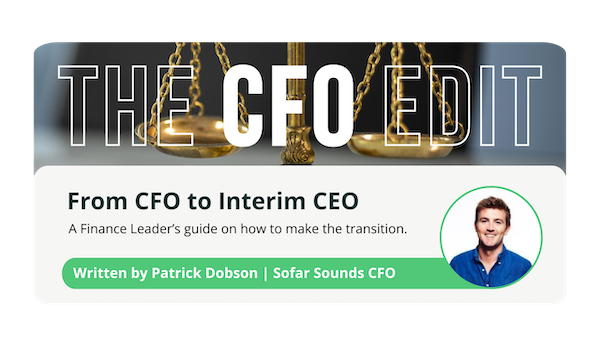
The CFO Edit | Closing the Blind Spot on Sustainability
24 Sept, 20259 minutes
For more than a decade Mike Bascombe, ESG & Sustainability Leader has been working with companies of every size and ambition, from Dentsu, Paramount and Google to Elastic, Amazon and GSK, to help them understand why treating sustainability as a side project is not only a mistake, but a missed opportunity. In recent years, Mike’s focus has been working directly with CFOs of private equity backed businesses, where the pressure to prove value is sharper and the timelines shorter.
In this article, Mike shares why sustainability should be treated in the same way as technology transformation, efficiency modelling or financial restructuring, and how it touches capital, risk and valuation more directly than many expect.
The blind spot on sustainability
Throughout my sustainability career I have described sustainability in a myriad of ways. The moral approach (you should do…), the creative approach (we could do…), the regulatory approach (you must do…), but so much of this has resulted in a lack of engagement and worse, an alienation of sustainability from the people who need to engage with it the most.
My role has been to translate what is too often dismissed as an ‘ESG project’ into something that speaks the language of capital, risk, and value. Over time I have noticed the same blind spot. Sustainability is still treated as an other. It is presented as a service line, a reporting obligation, or a reputational exercise. It is rarely placed alongside the familiar levers of value creation like technology, efficiency, capital allocation, and financial restructuring. That is a mistake.
I need to take some responsibility for this mindset. The consulting industry, myself included, helped to create it. By building sustainability practices and selling them as separate services, we reinforced the idea that ESG was optional or secondary, a box to tick in addition to the main business agenda. Strip away the jargon and the branding and the picture is different. Sustainability is not a side project. It is a business tool. It belongs in the CFO’s toolkit alongside every lever used to drive valuation.

Investors and markets are sending a signal
Investors are already telling us they expect this integration. In PwC’s most recent global investor survey, 71 percent of investors said ESG should be incorporated directly into corporate strategy and half said it is very or extremely important that companies change how they create, deliver and capture value in response to climate change. (PwC)
CFOs of high growth companies know what drives enterprise value.
- EBITDA expansion comes from efficiency gains.
- Multiple uplift comes from a credible growth story.
- Risk reduction lowers the cost of capital.
- Disciplined allocation protects cashflow resilience.
Yet when sustainability comes up, many CFOs still default to thinking of it as compliance, reputation, or something to delegate to a small specialist team. Each of these frames is limiting. Compliance ensures minimum standards but not strategic advantage. Reputation management keeps you on the defensive. Delegation strips finance of control over data that investors increasingly expect to be finance grade. The market signal is clear. BCG’s latest analysis shows that as the share of green revenue rises, valuation multiples rise with it, from an average premium of about 4 percent at a 10 percent green revenue share to around 13 percent at a 60 percent share. (Boston Consulting Group)
Finance is also where the cost of capital signal shows up first. Multiple studies now point to a consistent relationship between stronger ESG performance and cheaper financing. MSCI’s 2024 work found a significant historical correlation between higher ESG ratings and lower financing costs in both equity and debt markets, confirmed using market based proxies like beta and credit spreads. (MSCI) Independent bond market research suggests a measurable effect at issuance. One large cross country study of more than twenty five thousand bonds reports yields roughly 10 basis points lower for high ESG issuers in the primary market. (SSRN) The green bond literature points to a “greenium”, where green bonds price at lower yields than conventional bonds, with recent work by the Federal Reserve estimating an average eight basis point advantage in corporate markets, even as more recent analyses note that the size of that greenium can vary by year and market conditions. (Federal Reserve) None of this is abstract. Cheaper debt changes hurdle rates. Lower spreads show up in valuation.
Regulation and data discipline
Regulation is moving toward finance grade expectations. The UK has consulted on adopting the ISSB’s IFRS S1 and S2 into law, with the government signalling a decision in 2025 and a start from 2026 for listed companies, bringing climate and broader sustainability disclosures into the mainstream of financial reporting. (Reuters) Investors are pushing in the same direction. The message is simple. This is not a narrative exercise. This is a data and controls exercise that affects capital decisions.
At its core, sustainability is a data management and capital allocation challenge. Most finance teams are set up to handle structured, rules based data under GAAP or IFRS. Sustainability data is different. It is fragmented, unstructured, and often reliant on external sources. Left unmanaged, it creates late night spreadsheet scrambles, ballooning reporting costs, and audit exposure. Treated with the same discipline as financial data, it becomes a source of value. Market evidence shows the direction of travel. High quality ESG information can reduce audit pricing by conserving audit effort, a finding echoed in recent peer reviewed research on the link between ESG information quality and audit fees. (PMC) Automation also matters.
Outside the ESG niche, broad based enterprise data shows the cost and efficiency effect of automation, with nearly 40 percent of organisations reporting at least a 25 percent cost reduction and about half reporting efficiency gains of 25 percent or more. (PR Newswire) The same pattern is showing up in ESG reporting teams trying to move from manual work to platform workflows, with most practitioners saying they are still struggling to adapt processes to new rules, a sign of the opportunity left on the table when finance does not take ownership. (workiva.com)

From compliance cost to value creation
I have seen this shift first hand. When CFOs move sustainability reporting from manual workarounds into structured platforms, the results are measurable. Fewer wasted hours, faster cycles, fewer management letter points, and lower assurance effort. Those savings are not marginal when you place them against rising audit fees and regulatory expectations. In the UK market, audit fees have risen sharply in recent years. If you can reduce avoidable scope creep by improving ESG data quality, you are protecting operating costs in an area that has otherwise seen a 75 percent increase in five years for listed companies. (Financial Times)
Sustainability also shows up in lending markets in ways CFOs cannot ignore. Sustainability linked loans tie loan pricing to performance on agreed ESG targets. The evidence base is still developing, but the structural point is clear. Spread mechanics are now routinely linked to ESG outcomes, which means execution quality on those outcomes has a direct cash cost for the treasury team. (business.rutgers.edu) No CFO wants a loan spread step up because a target was missed due to poor data lineage or unclear ownership.
Aligning ESG with strategy
The consultant’s role in all of this is not to sell sustainability as a standalone programme. The role is to start with the company’s strategy. Are you preparing for IPO. Are you gearing for a private equity exit. Are you entering new markets or pursuing M&A. Only once those questions are answered can you determine what value creation means in context.
The next step is to match sustainability levers to those goals. If you are energy intensive, carbon intensity reduction is not about optics. It is about margin resilience. If you are aiming for a PE exit, supply chain transparency and audit ready ESG data protect and can enhance the multiple at exit. If you need international capital, credible disclosures shorten the trust gap with new investors. Finally, it is about implementation. Advisory is not enough. Execution matters. That means designing finance grade data models, implementing platforms, building governance, and producing outputs the CFO can defend in front of boards, auditors, and investors. When you do this, you move sustainability from narrative to numbers.
Working with CFOs over the past decade has taught me the same lesson time after time. The ones who treat sustainability as a valuation lever win.
CFOs who integrate ESG into their finance stack typically:
- Automate data capture
- Link non-financial KPIs to cashflow
- Report with credibility investors trust
- Save money through efficiency and reduced audit effort
- Secure better financing terms
- Build stronger investor confidence
The market response supports them. Companies that grow their share of green revenues tend to earn higher valuation multiples, and the relationship is not flat. The premium increases with that share.. (Boston Consulting Group)
On the other side of the ledger, CFOs who keep sustainability at arm’s length face the opposite outcome. They often:
- Delegate ESG to small teams and lose visibility
- Rely on spreadsheets and manual processes
- Scramble at reporting deadlines
- Pay higher audit fees
- Struggle with sceptical investors
- Miss out on valuation upside
The difference is mindset. One group asks how sustainability improves EBITDA, reduces risk, or strengthens the multiple. The other asks only what disclosures are required to stay compliant. One creates value. The other spends money to stand still.

ESG as a valuation lever
For scaleup CFOs, especially in PE backed or Series C plus environments, this choice is urgent. You operate under short horizons and high stakes. Your investors expect proof of valuation growth within tight timeframes. Your boards demand resilience and optionality. Your teams need clarity and efficiency. Sustainability is not a distraction from those goals. It is a lever to achieve them. In private equity contexts, buyers increasingly expect clean, auditable ESG data, and weak data can stall diligence or reduce price. In IPO preparation, regulators and investors scrutinise non financial disclosures as closely as financials, and the UK’s likely adoption timeline for ISSB standards means that climate and broader sustainability information will be treated as part of mainstream reporting for listed companies from 2026. (Reuters) In high growth businesses, efficiency and resilience are paramount. Data operating models that bring sustainability into finance grade control do both.
Ignore sustainability and you risk more than compliance pain. You risk undervaluing your company. The empirical signals are pointing the same way. Investors want ESG integrated into strategy. Valuation premia align with green revenue share. Stronger ESG is associated with lower financing costs and, in many cases, lower yields at issuance. Better ESG information can reduce audit pricing. Automation at scale is already cutting cost and improving efficiency for firms that move decisively. (PwC)
This is why I argue that sustainability is not ‘other’. It is not a service line. It is not a tick box. It is another lever of enterprise value, as tangible as margin expansion, capital allocation, or efficiency modelling. CFOs should demand ROI based sustainability proposals, measure ESG levers against cashflow and valuation, and treat non financial data as finance grade. Consultants should stop selling ESG as an add on and integrate it into the CFO’s standard toolkit. The CFO who reframes sustainability as a valuation lever gains an edge. They reduce cost, reduce risk, strengthen access to capital, and position their company for a higher multiple when it matters most. The question is no longer whether to engage with sustainability. The real question is whether you are leaving value on the table by failing to embed it as a lever today.
If you would like guidance on how to add sustainability to your value creation toolkit, get in touch with Mike - Mike.bascombe@vantagepoint.consulting



